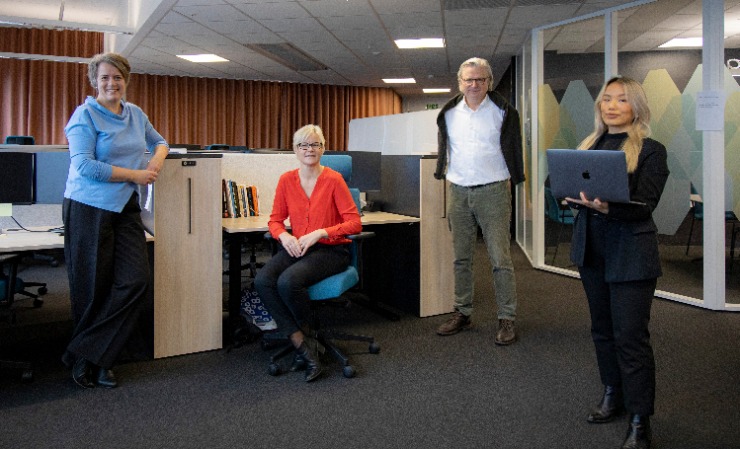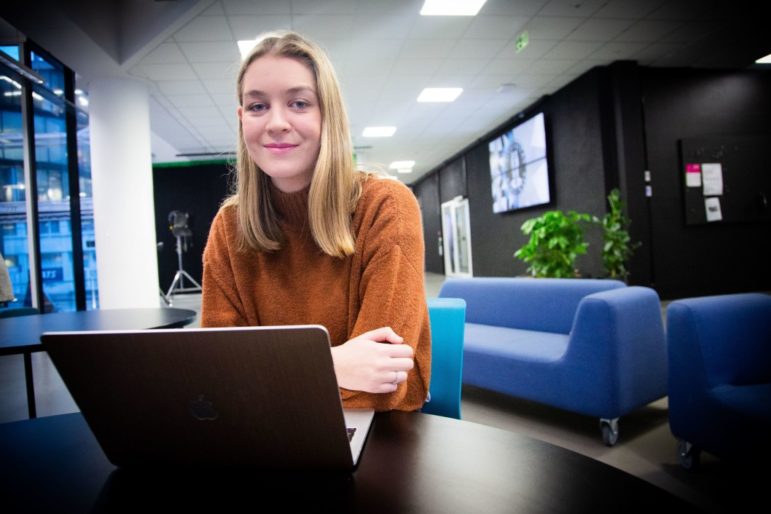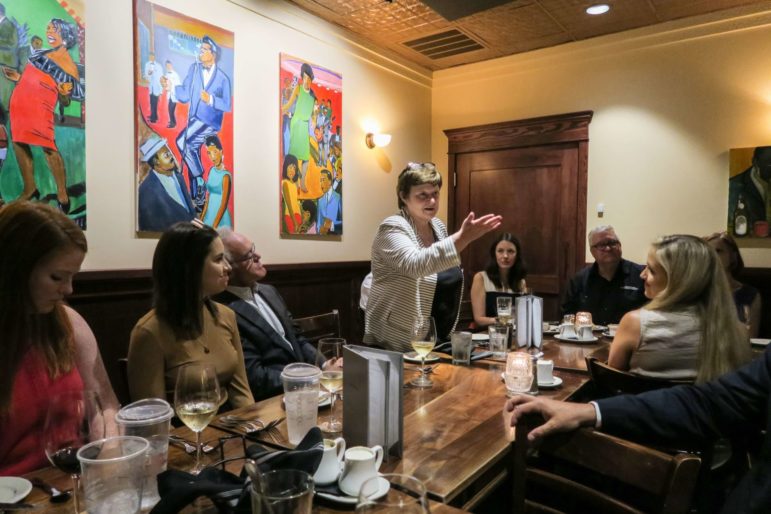This story was originally published by the Global Investigative Journalism Network. Also check out IJEC’s overview of investigative centers linked to universities.
It was a trip to the University of California, Berkeley, that first got the Norwegian journalist Per Christian Magnus thinking. During his visit, in 2009, he learned of the Investigative Reporting Program at Berkeley’s Graduate School of Journalism, which teaches students muckraking by having them work on, and publish, their own investigations, in association with some of the top media outlets in the U.S.

“Our students graduate with a master’s degree in one hand and a Pulitzer Prize in the other,” Lowell Bergman, the program’s founder and a former 60 Minutes producer, told him then. That struck a chord with Magnus, who returned to Norway determined to reproduce that model.
Universities might seem an unlikely venue for investigative journalism. But proponents say higher ed can play a vital role at this time of crisis for the news media.
A decade on, he has finally done so. In 2018, University of Bergen launched the Senter for undersøkende journalistikk (SUJO), or Center for Investigative Journalism, with a modest initial intake of just four graduate students.
About 30 more students have since joined the master’s program, which assigns one semester to coursework and a further three to original reporting, in collaboration with Norway’s top newspapers and broadcasters. Magnus, whose career as a reporter, editor, and documentary filmmaker spans 30 years, heads the center.
A year-long investigation by student Johanna Magdalena Husebye, one of the program’s first students, appeared as a two-part series on the front page of one of Norway’s most widely read newspapers, Verdens Gang, in May 2019. The series sparked a national debate on the taboo subject of elderly suicide, and was even nominated for a SKUP Award, Norway’s answer to the Pulitzer. SUJO was off to a propitious start.
More and more universities are devoting resources to the teaching and practice of investigative journalism. Six recently launched academic centers, including SUJO, joined the Global Investigative Journalism Network in October last year. These new members stretch from North America to Northern Europe, but this same model has traveled even farther afield.
South Africa’s University of the Witwatersrand (known as Wits) became home to an investigative center in 2008, as did Colombia’s University of the Andes in 2011, and Japan’s Waseda University in 2016. Forensic Architecture, a 10-year-old research agency based at Goldsmiths, University of London, has produced dozens of investigations on subjects as varied as the use of tear gas in Chile and the destruction of rainforests in West Papua. GIJN estimates that nearly half its membership now has some affiliation with academic institutions, through teaching and training but also through office spaces, student internships, and direct sponsorship.
University-based investigative centers have multiplied at pace. But what lies behind this growing trend?

Safe Havens
Universities might be viewed an unlikely venue for investigative journalism. Contemporary academia, which is often slow, insular, and hyper-specialized, can seem at odds with the urgency of public-interest reporting. But proponents of this model say higher education institutions can play two vital roles for contemporary news media: foster the next generation of investigative journalists, when few newsroom traineeships are available, and provide the support needed to undertake complex investigations as newspaper closures and shrinking budgets impede costly reporting projects.
“Universities offer safe havens for work that may be risky and difficult,” says Anton Harber, a professor of journalism at Wits and a GIJN board member.
Harber founded the Wits Justice Project (WJP) after being inspired by the pioneering work of the Medill Innocence Project, which was established at Northwestern University, near Chicago, in the 1990s. One of the earliest university experiments in investigative journalism, the Innocence Project combined the efforts of the Medill Journalism School faculty and student body to investigate potential wrongful convictions in the U.S. state of Illinois. (After a string of high-impact reports, the Innocence Project has more recently itself faced scrutiny.)
WJP, which is part of the Wits journalism department, also investigates miscarriages of justice, but in South Africa. It has helped at least two men wrongfully convicted of murder to overturn their life sentences.
“Investigating these cases needed time and a long view,” says Harber, who co-founded the Mail & Guardian, for decades that country’s most respected political and investigative publication. “We created the space for these long-term investigations which are difficult to do in conventional newsrooms, certainly in this country.”
Though WJP staff do on occasion teach Wits students, the project is first and foremost an investigative news outlet, which produces and publishes its own work. A university-based Marshall Project, if you will.
SUJO, on the other hand, puts training at the heart of everything it does. The Norwegian center does not act as a newsroom, nor does it publish its own work. Instead, it teaches Bergen students the rudiments of investigative journalism then sends them off to collaborate with established media outlets. SUJO also holds workshops for publications, helping working journalists to hone their investigative skills and assisting them through every stage of complex reporting projects.
A Collaborative Approach

Some universities stand halfway between the WJP and SUJO approaches. The Institute for Investigative Journalism (IIJ), at Concordia University, in Canada, sees itself both as a place of learning and a national newsroom. The same is true of the Michael I. Arnolt Center for Investigative Journalism at Indiana University in the U.S. Both centers partner with media outlets to produce and disseminate the collaborative investigations of students and professional reporters.
The Arnolt Center is working on six projects with Gray Television (which owns about 150 stations across the U.S.) and Gannett (which published some 250 daily newspapers, including USA Today). In the future, it may partner with even more organizations, including the Howard Center for Investigative Journalism at Arizona State and the University of Maryland, says founding director Kathleen Johnston. An Indiana graduate and former CNN and CBS News investigative producer, Johnston has acted as teacher and editor to the Arnolt students since the center’s opening in 2019, but she hopes the newsroom will one day be entirely student-run.
Universities sometimes find that hosting adversarial reporting strains relationships with funders.
As for IIJ, it is leading a data project tracking local coronavirus infections across Canada, alongside 12 other Canadian universities and at least seven major media outlets, both Francophone and Anglophone. Concordia and its partner universities have led insightful investigations into worrying levels of lead in drinking water, water issues in Canada’s First Nation Indigenous territories, and the power wielded by the oil and gas industry.
“I felt that, with the decline of the media industry, universities might become central providers of accurate information,” Concordia graduate Patti Sonntag says of why she founded IIJ in 2018, after over a decade as an editor at The New York Times. “In some major Canadian cities, university publications are now competitive with leading city newspapers and news organizations.”
Gaining and Losing Sponsors
University programs focused on investigative journalism have existed for some time. But it was only after the 2008 economic crisis — alongside the collapse of journalism’s traditional business model — that they became widespread, according to Sheila Coronel, who helped pioneer the model in 2006 by founding the Toni Stabile Center for Investigative Journalism, at New York’s Columbia University.
Investigative centers within universities can tap into a variety of funding sources. The Arnolt Center has so far largely relied on a $6 million endowment from Indiana University alumnus Michael Arnolt, a journalism major and wealthy businessman.
SUJO has received grants totaling 3.5m Norwegian kroner ($410,000) annually from the free speech foundation Fritt Ord and the savings bank Sparebanken Vest, supplemented by 1.5m kroner of university funding. The external grants will end this year, but SUJO believes it can make up the shortfall by charging mainstream media organizations who send journalists to its workshops.
Concordia University’s IIJ has secured funding from the Google News Initiative’s Innovation Challenge to launch a data hub for journalism collaborations and information sharing; a $110,000 gift from the Inspirit Foundation will help fund the hire of an investigative reporter. Also in Canada, the University of British Columbia’s Global Reporter Centre has won innovative backing from the Social Sciences and Humanities Research Council of Canada and the Canadian Institutes of Health Research, as well as major foundations.
Still, universities sometimes find that hosting adversarial reporting can strain relationships with funders.
Such was the case at Columbia University in 2007. The telecoms group Verizon, which was subsidizing the school’s “First Amendment Breakfast” lecture series, was dismayed that Stabile students had partnered with the Times Union, a local daily, to investigate the emergency federal aid Verizon received after the September 11 attacks.
Coronel recalls a lengthy conversation with a “very upset” spokesperson for the firm who questioned why students were being allowed to work on such serious stories. Verizon subsequently stopped funding the lecture series, offering little by way of explanation for its decision. (Verizon did not respond to a request for comment.)
At the University of Wisconsin-Madison in 2013, the Republican-led Wisconsin legislature sought to leverage the university’s reliance on state funding to force the Wisconsin Center for Investigative Journalism off the campus, reportedly because of the center’s perceived liberal bias.
Academy Versus Practice
Beyond funding sources, university centers vary in other ways, too. While the Arnolt Center’s charter guarantees Indiana University will have no prior review nor decision-making authority over its work, South Africa’s WJP discusses its reporting with the journalism department, and informs university lawyers before publishing particularly controversial investigations.
WJP’s Harber says this is only fair; the university has committed to defending the project in court if it comes to that. (He adds that the university has never censored the Project.) Johnston says Indiana University also backs the Arnolt Center legally.
Having the support of a major institution is one of the perks of belonging to a university, interviewees told GIJN. It deters prospective plaintiffs, who might otherwise sue a small, independent outlet. It also confers upon journalists a measure of academic standing, at a time when the reliability of the news media is frequently brought into question.
“Groups like the Arnolt Center and the Howard Center are going to fill a void. Not yet, maybe — we’re just a little drop in the bucket right now — but we’re growing.”
The Arnolt Center’s Kathleen Johnston
But this association is not without headaches. Harber speaks of a “tug of war between academy and practice,” for example when the university requests that journalist hires fit neatly within a pay scale designed for scholars and administrators. “It’s a big, bureaucratic organization that’s not set up to do that kind of thing,” he says. “It’s complicated, but we do find our way through it.”
Meanwhile, Johnston says she values Arnolt’s independence because Indiana University has its “sacred cows,” as any organization does. Magnus says that while the university has been tremendously supportive thus far, he does expect internal politics to create hurdles for SUJO eventually. “Those days will come,” he says. “We are going to have a new rector this year, I will get a new boss; and universities are well known for their power fights and backroom quarrels.”
A Growing Trend

Such difficulties proved too much for Waseda Chronicle. The Tokyo-based investigative journalism outlet severed all ties to Waseda University in early 2018. (The Chronicle will soon change its name to Tokyo Investigative Newsroom Tansa to signal that split.)
“Originally I envisioned Waseda Chronicle continuing at Waseda University indefinitely, because having an investigative journalism organization in the university seemed great in principle,” Chronicle founder and chief editor Makoto Watanabe told GIJN via an interpreter, reporter Annelise Giseburt.
The university’s perceived openness to the public, and the prospect of both teaching and practicing journalism, were the main draws. “In practice, it didn’t quite live up to the lofty ideals.”
The university hosted the Chronicle but gave it no real support, according to Watanabe. It rented office space from the university at commercial rates, he says, and was hindered in its ability to raise funding because of university rules. While the then-head of Waseda University’s Institute for Journalism was supportive of the project, in Watanabe’s telling widespread institutional support was lacking. (Waseda University did not respond to a request for comment.)
When told of the achievements of other university-based investigative centers, and in particular of the Arnolt Center’s funded — yet fully independent — model, Waseda Chronicle’s Giseburt joked: “We should move to Indiana!”
Johnston, who is professor of professional practice at Indiana University’s Media School, beyond her role at the Arnolt Center, is optimistic about university-based projects. “As newspapers and other media outlets are so troubled, groups like the Arnolt Center and the Howard Center are going to fill a void,” she said. “Not yet, maybe — we’re just a little drop in the bucket right now — but we’re growing.”